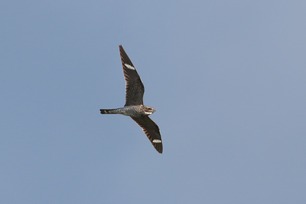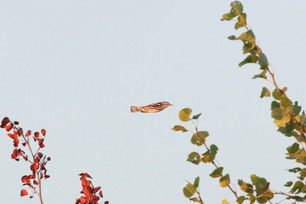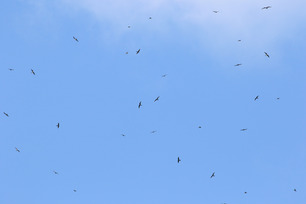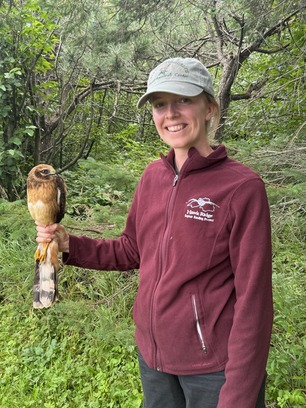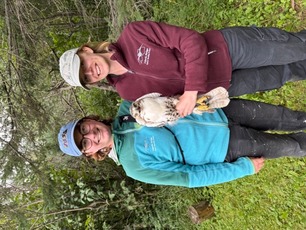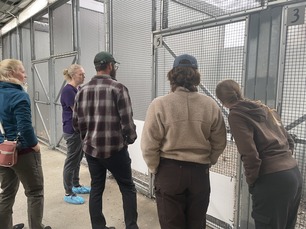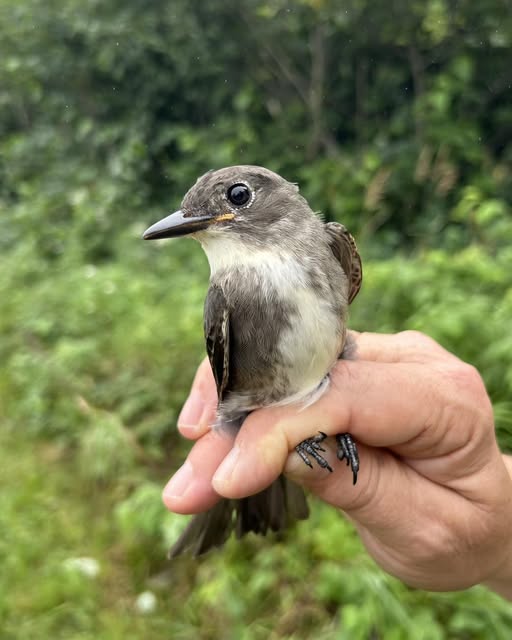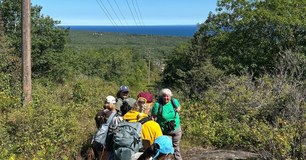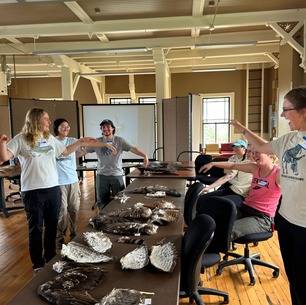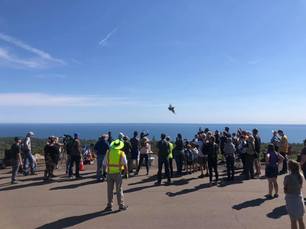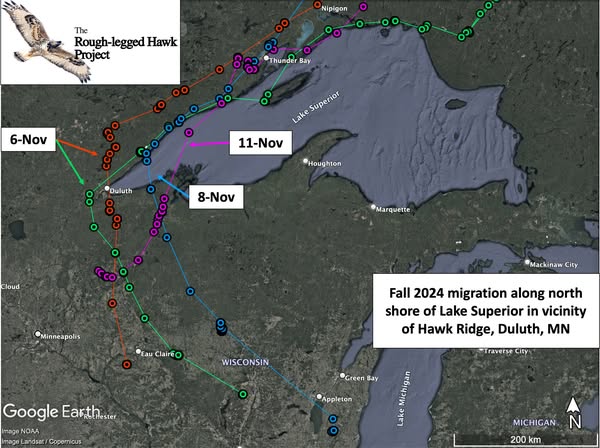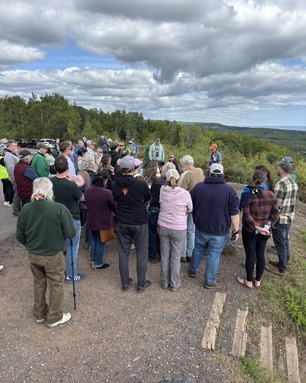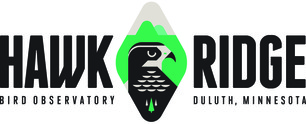
Dear Hawk Ridge Friends,
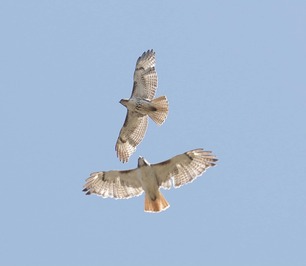
October is here and we are excited to welcome many of our larger raptor migrants, such as Red-tailed Hawks, Rough-legged Hawks, American Goshawks, Bald & Golden Eagles. With the fall colors and nice temperature, it's a wonderful time to come out and visit! Join us for one of our upcoming evening owl programs, weekend public programs, or stop by anytime 9am-4pm to learn about the migration from our staff and volunteers. Check out the September count & banding summaries below and info on upcoming events.
P.S. If you missed our last e-newsletter, you can view that and older versions by clicking HERE.
September 2025 Bird Migration Count Summary
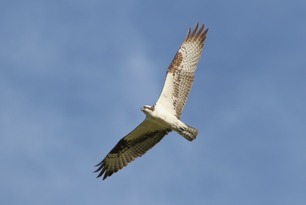
The Hawk Ridge Bird Observatory began its second month of the fall count on September 1, and tallied 24,321 migrant raptors and 169,547 migrant non-raptors (birds and insects)! The count was conducted every day from the 1st until the end of the month, totaling 272.42 observation hours. Weather was, as usual, temperamental. We began the month with several strong cold fronts and below average temperatures, and ended with high temperatures reaching into the 70s and 80s, well above average for late September. The week surrounding Hawk Weekend ushered in several days of dense fog and easterly winds, creating suboptimal conditions for Broad-winged Hawk migration. Let's dive into the stats!
September Raptor Highlights:
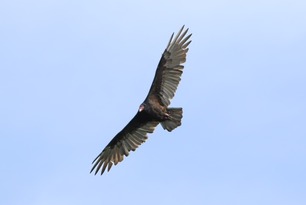
Turkey Vulture (441): Below Average–The vulture flight has been decent thus far, and falls 90 birds shy of the long term average. Peak day was 78 on 9/24.
Osprey (149): Below Average–Osprey counts in September continue to trend downwards since the 1990s. The 10 year average of 171.5 contrasts strongly with the long term average of 207.5.
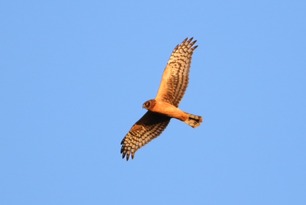
Bald Eagle (2,076): Above Average–The fourth best September tally of Bald Eagles at Hawk Ridge! We counted 100+ on seven days, with a high count of 284 on 9/6.
Northern Harrier (322): Above Average–Our harrier count sits comfortably above the long term average of 299. Harriers finished strongly this month; 182 were counted in the last week of the month.

Sharp-shinned Hawk (11,117): Above Average–Highlighted by the fourth highest count of Sharp-shinned Hawks in Hawk Ridge history (1,969 on 9/23), it is a treat to see so many sharpies on the ridge. Hawk Ridge continues as one of the few count sites in North America with stable Sharp-shinned Hawk counts in the 21st century.
Cooper’s Hawk (43): Below Average–The second most common accipitrine fell just shy of the average this month.
American Goshawk (5): Below Average–The least common accipitrine this month. A glimmer of hope exists in the sighting of an adult Goshawk near the end of the month, a brief but tantalizing callback to the irruptions of yesteryear.
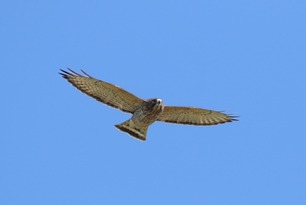
Broad-winged Hawk (8,313): Below Average–Several days of dense fog shrouded the ridge like a nasty cold that we just couldn’t shake in the peak window of flight. Our best day for Broad-winged Hawks delivered 6,110 on 9/17. Forever an unpredictable goddess, the winds of the northwest failed to arrive just when the Broad-winged Hawks needed them, likely allowing many to pass away from the shore.
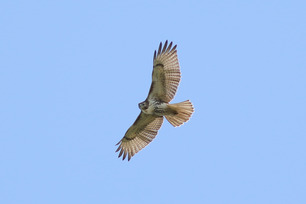
Red-tailed Hawk (302): Below Average–Red-tailed Hawks are a classic late season raptor that can occasionally show well in September. Our most significant Red-tailed Hawk flight (83 on 9/26) were actually more numerous than Broad-winged Hawk on that given day.
Swainson’s Hawk (3): Below Average–With a long term average of 4, our 3 Swainson’s Hawks is a solid output. There were at least 4 Swainson’s in the area this month, with the fourth being an individual banded at Moose Valley, NE of the main overlook.
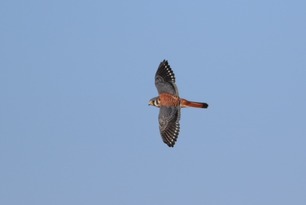
American Kestrel (1142): Above Average–100+ Kestrels were counted on three days this month, with a particularly good flight of 192 on 9/25. It was a good month for falcons across the board, with most large flights attributed to SW winds.
Peregrine Falcon (101): Above Average–Back to back days of 17 Peregrines on 9/25 and 9/26 helped to blast our count over the 3-digit barrier, a feat only accomplished five times previously!
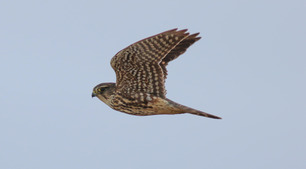
Merlin (302): Above Average–This year's count is the highest September Merlin total in the 53-year history of Hawk Ridge! Amazingly, migrant Merlin were counted every day except for 9/22, when no migrating raptors were counted.
Unknown (5)
Non-raptor Highlights:
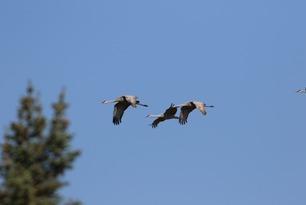
This month, we counted 169,547 migrant non-raptors of 107 species! We started off the month with a major Common Green Darner flight. While keeping tally of birds as our primary focus, we count dragonflies when possible. 57,000 Green Darners on 9/1 was surely an unforgettable experience. Also on the invertebrate side of the coin was an incredible movement of Mourning Cloak butterflies, a species typically thought of as non-migratory. We obviously are challenging that understanding, as we have recorded 354 Cloaks this month, and a high count of 94 on 9/21!!
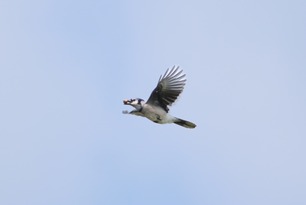
The excitement continues in the world of birds. 7,732 Canada Geese flew past the ridge, with 3,073 in a single day, a new county high count. Hummingbirds wrapped up mid-month, and we counted 75 on their way south. A Great Egret (9/1), a Red-shafted Flicker and Dickcissel (both 9/29) were some of the more unusual migrants. Corvid migration was excellent this month. Blue Jays (70,638) were omnipresent, and we have had consistent flights of Common Raven (376). American Crows (279) are just beginning to pick up. While Cedar Waxwings (4,487) were one of the more numerous species in morning flight, these counts are quite a bit lower than average. There was another notable sighting of early Bohemian waxwing (5) on 9/9.
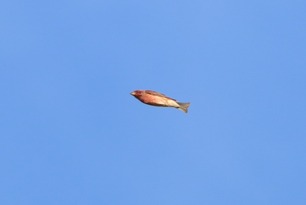
There is a whisper of a chickadee irruption shaping up, and we have noted a few Black-capped migrants and one Boreal Chickadee at the Ridge! It seems that Red-breasted Nuthatches (273) are slowing down, but not after migrating in above average numbers for several weeks. It seems to be too early to tell what winter finches may irrupt this winter, but the early season species, Purple Finch (3,141) and American Goldfinch (1,143) are counted daily in good numbers. Common Grackle (2,665) were the only blackbird to reach the 1,000+ monthly total. In the warbler world, we experienced excellent diversity, but numbers were somewhat reduced in active migration.
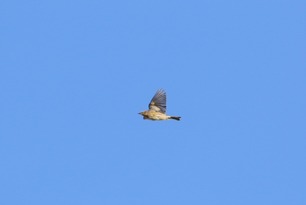
In order of abundance: Yellow-rumped Warbler (7,830), Unidentified warbler (3,515), Palm Warbler (468), Tennessee Warbler (263), American Redstart (214), Nashville Warbler (158), Cape May Warbler (137), Magnolia Warbler (35), Bay-breasted/Blackpoll Warbler (30), Northern Parula (28), Blackpoll Warbler (26), Bay-breasted Warbler (23), Chestnut-sided Warbler (14), Black-and-white Warbler (14), Black-throated Green Warbler (8), Northern Waterthrush (6), Wilson’s Warbler (3), Blackburnian Warbler (2), Connecticut Warbler (1).
A huge thanks to Counters Marie Hosch and Peter Mundale for your dedication to the count, our newest batch of trainees hard at work on the platform, our roadside Mourning Cloak alert team, and all who chose to visit Hawk Ridge this past month! You all make this place a treasure, and there is nowhere else I would rather spend a fall day. Counts at Hawk Ridge continue every day until the end of November. See you at the watch soon! Be sure to follow along with the live count on Trektellen HERE and raptor count on HawkCount HERE.
Sean McLaughlin
Lead Counter
September 2025 Banding Summary
September Raptor Banding Totals:
In what seems to be the new norm, September featured unseasonably high temperatures and long stretches of light easterly winds, along with multiple days of fog that severely limited banding. Though the birds were still moving, the days that should have been our busiest were instead marked by flightlines either incredibly high or far to the lakeside. While we logged the hours, we banded only 708 raptors in September, well below last season’s 825 raptors and continuing a now 4-year trend of well-below-average September capture numbers.
The Hawk Ridge station was covered all 30 days of the month, with 485 raptors banded. The Moose Valley station was covered 29 days, with 193 raptors banded. The Paine Farm station was covered 11 days, but with only 30 raptors banded due to the exceptionally poor winds and flightlines. Most species are below average for this point in the season, particularly Sharp-shinned and Red-tailed Hawks. It is likely that these low numbers are a reflection of the poor banding conditions throughout most of September, rather than any great decline in actual populations.
However, all was not lost with Merlins on their way to be at or above average this year. While a hatch year Swainson's Hawk is only the fourth banded here since 2011. Three Bald Eagles are even more noteworthy as this is the most banded in a season since 2018, and first time three adults have ever been banded in a season at Hawk Ridge.
Total raptors banded in September were as follows:
Sharp-shinned Hawk – 550
Cooper’s Hawk – 13
Northern Harrier – 17
Broad-winged Hawk – 3
Swainson's Hawk - 1
Red-tailed Hawk – 9
American Kestrel – 31
Merlin – 83
Bald Eagle – 3
Total: 708
Follow along here for raptor banding numbers throughout the season on Trektellen Hawk Ridge Raptor Banding.
Tim Baerwald
Lead Bander
September Owl Banding Totals:
The 2025 fall owl banding season began on September 15th. Despite a few windy nights we have had a solid start to the season, banding 354 Northern saw-whet owls, including hatch year, second year, after hatch year, and after second year individuals. Excitingly, we also captured 9 previously banded owls. We recaptured two owls previously banded in Washington County, MN, one banded in Mackinac County, MI, one banded in Portage County, MI, and one banded this spring in Keweenaw County, MI by Hawk Ridge’s lead raptor bander Tim!
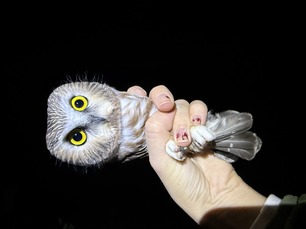
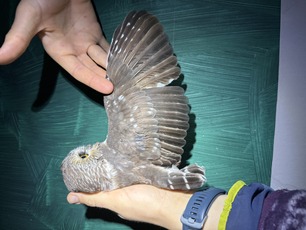
Other unexpected visitors to our owl nets include a hatch year male Eastern Whip-poor-will which we banded and aged by the shape and amount of white at the end of his tail, and two bats (an Eastern red bat, and likely a Hoary bat). We also were lucky enough to see incredible Northern lights two nights - the benefits of nocturnal work! We are looking forward to more owls in October - maybe we’ll get our first long-eared? Special thanks to the owls and the wonderful apprentices, trainees, and volunteers for their hard work.
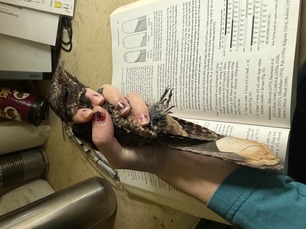
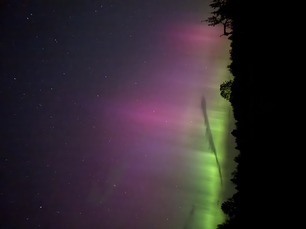
Follow along here for raptor banding numbers throughout the season on Trektellen Hawk Ridge Owl Banding.
Maya Vernick
Fall Owl Bander
September Passerine Banding Highlights:
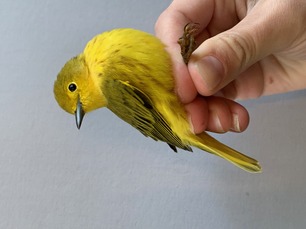
September was a good month for passerine banding. We were able to band for 25 of the 30 days in the month. The weather was very cool for the first part of the month but it warmed up dramatically towards the end when morning temperatures were often around 60 degrees which is at least 10 degrees above average. We banded 928 birds of 47 species. Year to date, our top birds banded are American Redstart (238), Swainson’s Thrush (219), White-throated Sparrow (170), Magnolia Warbler (125), and Nashville (75) and Tennessee Warblers (75). Highlights for September were multiple Blue-headed Vireos (7), higher than average Blackpoll Warbler at 13 birds and Northern Parula at 14 birds. Ovenbirds (66) and Purple Finch (24) were also above average.
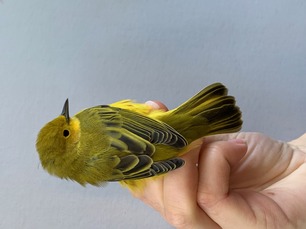
Pictured is the only Yellow Warbler we have banded this season, a comparatively unusual warbler at our station and the only warbler here with yellow tail feathers including the vanes of the tail feathers, so it easily stands out from the crowd. We have also noticed a much larger than normal number of Black-capped Chickadees this year, with more than 65 banded so far this season, the largest number of Chickadees banded in the last 13 years of passerine banding is 49 for the entire season in 2012, it feels like perhaps we may have a Chickadee eruption happening! So stay tuned for more Chickadee updates.
%202.jpg)
As we move into October, the transition to late season is happening. We are catching more Hermit than Swainson’s Thrushes. The kinglets both Ruby-crowned, and Golden-crowned are moving through now as the nights get colder. The temperatures are forecasted to drop soon to more seasonal nights around 40 and days in the 50’s . We expect the sparrows to start moving through in bigger numbers and soon will be seeing more juncos, Fox Sparrows, White-crowned Sparrows, and finally American Tree Sparrows which are usually the last of the fall migrants to pass through on their way south.
Just like all our banding numbers, you can keep track of what we’ve been banding by visiting Trektellen - Hawk Ridge Passerine Banding. Thanks for your support!
David Alexander & Margie Menzies
Passerine Banders
Research Highlights
Linking Breeding and Migratory Bird Populations in Minnesota
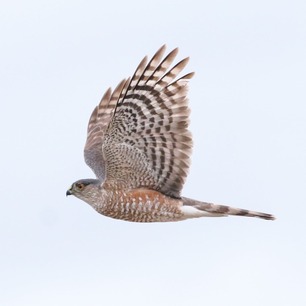
In September, we had some incredible flights of Sharp-shinned Hawks. According to the Raptor Population Index, these small, feisty hawks have been experiencing declines in some parts of their North American range. For the past two falls we have been studying Sharp-shinned Hawk migration and landscape usage through funding provided by the Minnesota Environment and Natural Resources Trust Fund as recommended by the Legislative-Citizen Commission on Minnesota Resources (LCCMR).
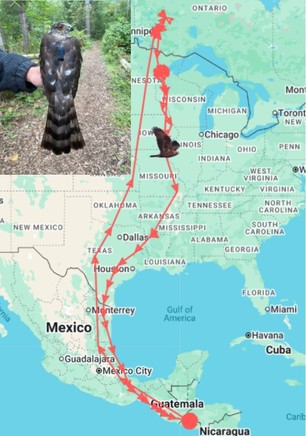
Two Sharp-shinned Hawks that were outfitted with GPS/cellular transmitters (from Cellular Tracking Technologies) last fall, just migrated back through Minnesota this past week (unfortunately neither flew past Hawk Ridge!). Both individuals spent the breeding season in Ontario after spending the non-breeding season in Central America (male in Mexico and female in El Salvador). Here at Hawk Ridge, many of the migrants we see are only spending a tiny fraction of their lives in Minnesota, so it’s essential to conservation to understand where they spend the rest of their lives and what may be affecting their populations in those locations. Wishing all the birds a safe journey!
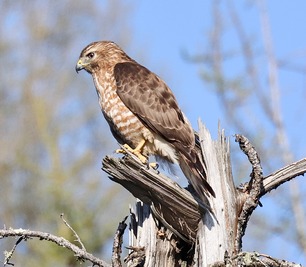
Broad-winged Hawk Project - DONATE TODAY!
We are collaborating with Hawk Mountain Association in Pennsylvania to study Broad-winged Hawks in the Central Flyway. To learn more about the goals of the project click HERE. To support the project through donating any amount or sponsoring a transmitter click HERE. Thank you for your support!
Hawk Weekend - Guatemalan Avian Researchers
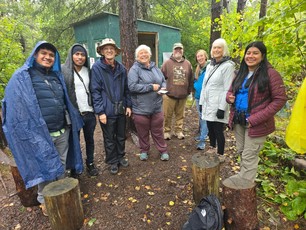
A group of avian researchers from Guatemala visited Hawk Ridge during Hawk Weekend Festival and spent time at the banding station. This group is led by Marcial Cordova who runs a MoSI station in Guatemala to monitor winter survival. The group was hosted by the Zumbro Valley Audubon Society (Eric Matteson). Despite the foggy, rainy weather the group was able to experience bird banding at Hawk Ridge and discuss opportunities for collaborations in the future. Thank you for visiting and we look forward to working with you on avian conservation!
Emily Pavlovic
Research Director
UPCOMING EVENTS
October 11th, 2025 @ Hawk Ridge!
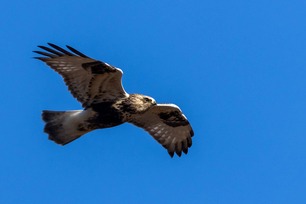
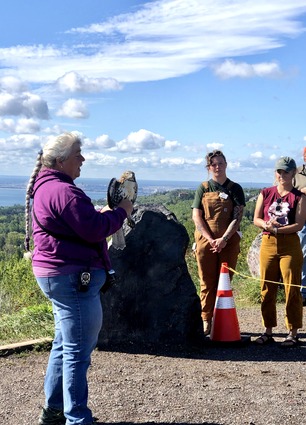
Plan Your Fall Visit to Hawk Ridge
September 1st - October 31st, 2025
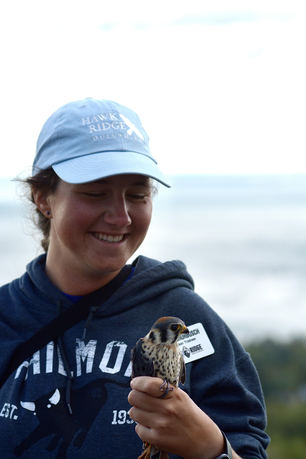
Daily 9am-4pm
Join us for the fall bird migration at Hawk Ridge Nature Reserve in Duluth, MN - one of the premier fall bird migration sites in North America! We look forward to connecting with visitors of all ages from around the world! Here are some helpful links with information on visiting this fall:
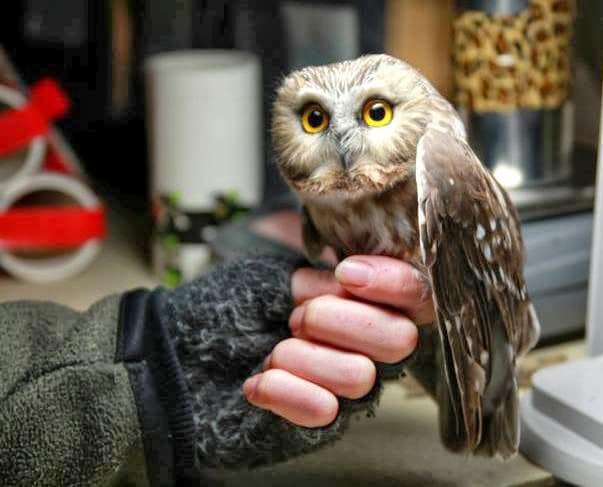
Whoo doesn’t like owls? From large to small, seasonal travelers, and hardy residents, Minnesota hosts a fascinating diversity of owls, with some crazy habits, and some hauntingly beautiful sounds in the night. Join us this fall to learn about the Hawk Ridge owl banding research through one of our public evening owl programs or schedule a small group owl program. Click HERE for more info.
Saturday evening public program:
Oct. 18th at 8pm
Tickets limited; $10 member/student or $15 nonmember
Small group owl programs (up to 8): offered Sept. 23-Oct. 31 (Tues. or Thurs-Sat. evenings) with date/time to be arranged by sending an email to owls@hawkridge.org. $40 member/student or $50 nonmember.
International Birding Tours 2026
Birding the Ruins of the Yucatan
February 11-21, 2026 (must register by Nov. 8th!)
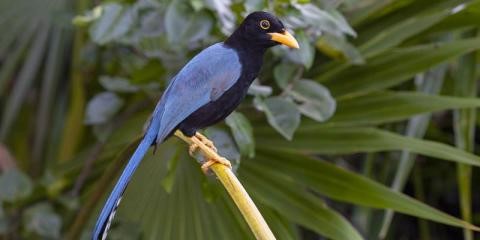
Join Hawk Ridge Education Director, Margie Menzies to explore a fun mix of birding and historical Mayan Ruins. These jungle archeological reserves in addition to having been critical to the Mayans are also great locations for the rainbow array of birds that inhabit the Yucatan. We will hunt for endemic species on the peninsula's North Coast, take boat rides on Bacalar Lagoon and Celestun River, and keep our eyes on the skies for fantastic soaring raptors, and much more.
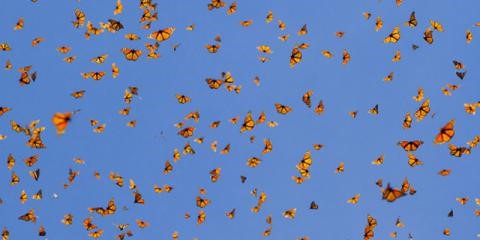
Optional Extension- Birds and Monarchs February 21-25, 2026 Travel on from the Yucatan to the higher elevations of the Central Mexico and Mexico City region. We'll travel to the Angangueo area, and visit El Rosario, the largest Monarch butterfly overwintering site, and enjoying the birds along with the butterflies at the mountain top, and all the way up and back down the mountain! We will also enjoy Agua Blanca, and other birding hotspots in the area.
Click on this link for an Overview, Itinerary, Pricing, Travel Information, How to Enroll and Resources. *Please note space is limited and deadline to register in full is November 8, 2025. This trip requires a minimum of 10 participants. Make a trip deposit to reserve a spot on the trip, but wait to make airline reservations and pay the full trip amount until you receive notice that the trip has reached its minimum enrollment. For more information or questions, please contact Debbie Jordan at debbie@holbrooktravel.com or 866-748-6146 or Hawk Ridge Education Director, Margie Menzies at mmenzies@hawkridge.org.
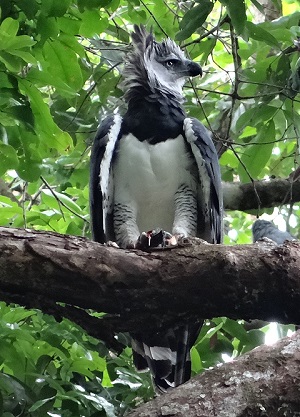
Panama Raptor Migration 2026
October 29-November 7 (optional pre-trip Oct. 24-29)
*SAVE THE DATE! Panama Raptor Migration
with Frank Nicoletti (with optional pre-trip extension Harpy Eagle and Darien Canopy)
More info coming soon - click HERE for details! or contact ginanichol@sunrisebirding.com
SAVE THE DATE!
Raptor Research Foundation Conference
October 26-30, 2026
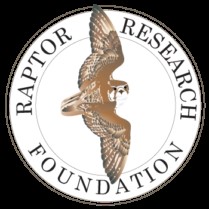
Hawk Ridge Bird Observatory is excited to announce we are hosting the international Raptor Research Foundation Conference next year! The conference will be held October 26-30, 2026 at the Holiday Inn Downtown Duluth. This year's 2025 conference is being held this fall in Costa Rica. We look forward to sharing more information with you later this winter! Find out more about the Raptor Research Foundation go to: raptorresearchfoundation.org.
OTHER NEWS
Hawk Ridge is Seeking Board Members!
Hawk Ridge Bird Observatory (HRBO) is seeking motivated and creative volunteers to join our Board of Directors. Qualified individuals will serve as ambassadors of our mission to promote conservation of raptors and other birds in the Western Lake Superior Region through research, education, and stewardship. We are looking for mission-aligned individuals, particularly those with interest or experience in fundraising, public relations, event planning, and/or marketing activities.
To apply please click HERE. You can also find more info about the board position HERE at hawkridge.org or under About Us-Board. Applications accepted until filled.
Thank You for Your Support!
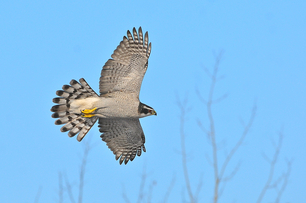 Hawk Ridge Bird Observatory thanks all of our supporters. We appreciate you! As a nonprofit organization, we are primarily funded by individual gifts to put our bird migration research and education programs in action. Below are some of the ways you can help us keep sharing the magic of the bird migration!
Hawk Ridge Bird Observatory thanks all of our supporters. We appreciate you! As a nonprofit organization, we are primarily funded by individual gifts to put our bird migration research and education programs in action. Below are some of the ways you can help us keep sharing the magic of the bird migration!
Support Hawk Ridge by Shopping!
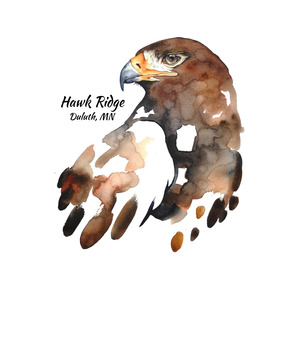
Be sure to check out our merchandise trailer at Hawk Ridge daily Sept. 1 - Oct. 31 9am-4pm (weather pending). We have 2 new Hawk Ridge shirts this fall with featured artists! New this year is the beautiful Golden Eagle by Kiley Busko! Kiley is a watercolor artist focusing on painting birds and other wildlife. She is from Minnesota and has her art at multiple galleries and shops throughout the Midwest. You can check out more of her artwork at paintedwing.com
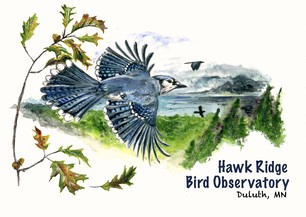
Big Frog (direct ship or pick up at Duluth store)
Become A Member Today!
If you're already a member of Hawk Ridge, we sincerely appreciate your support! THANK YOU! If you're not a member and have enjoyed your experience with Hawk Ridge, we invite you to renew or join as a Hawk Ridge member today! Our memberships and donations help drive our bird conservation research and education programs. You can check out our exciting membership benefits and join or renew online HERE!
Simply Donate
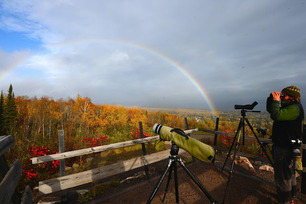 You can always simply donate online by clicking HERE or by mailing a check made out to Hawk Ridge Bird Observatory, P.O. Box 3006, Duluth, MN 55803.
You can always simply donate online by clicking HERE or by mailing a check made out to Hawk Ridge Bird Observatory, P.O. Box 3006, Duluth, MN 55803.
Thank you again for your wonderful gift of support! Hope to connect with you this fall at Hawk Ridge or feel free to reach out by email or phone!
Sincerely,
Janelle Long
Executive Director
Hawk Ridge Bird Observatory
Hawk Ridge Bird Observatory
P.O. Box 3006
Duluth, MN 55803-3006
Call: 218-428-6209
Contact: mail@hawkridge.org
Visit: www.hawkridge.org
501(c)3 Non-Profit Organization
Federal Tax ID 76-0746366

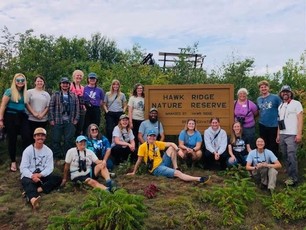
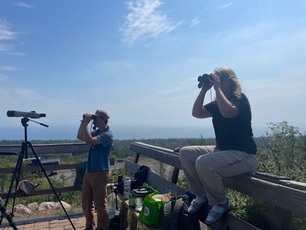
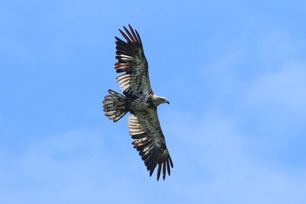 967 Bald Eagles is a new high count for the month at Hawk Ridge!
967 Bald Eagles is a new high count for the month at Hawk Ridge! 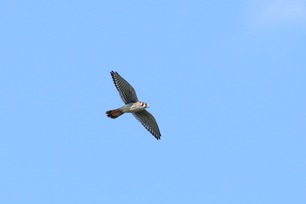 Osprey counts were about half of what we might expect, with only 15 in August.
Osprey counts were about half of what we might expect, with only 15 in August. 